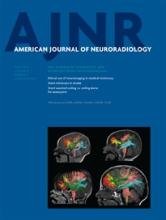Research ArticlePediatrics
Open Access
Role of Diffusion Tensor Imaging as an Independent Predictor of Cognitive and Language Development in Extremely Low-Birth-Weight Infants
U. Pogribna, K. Burson, R.E. Lasky, P.A. Narayana, P.W. Evans and N.A. Parikh
American Journal of Neuroradiology April 2014, 35 (4) 790-796; DOI: https://doi.org/10.3174/ajnr.A3725
U. Pogribna
aFrom the Division of Neonatology (U.P., K.B., R.E.L., P.W.E., N.A.P.)
K. Burson
aFrom the Division of Neonatology (U.P., K.B., R.E.L., P.W.E., N.A.P.)
R.E. Lasky
aFrom the Division of Neonatology (U.P., K.B., R.E.L., P.W.E., N.A.P.)
P.A. Narayana
bDepartment of Pediatrics, and Department of Radiology (P.A.N.), University of Texas Health Science Center, Houston, Texas
P.W. Evans
aFrom the Division of Neonatology (U.P., K.B., R.E.L., P.W.E., N.A.P.)
N.A. Parikh
aFrom the Division of Neonatology (U.P., K.B., R.E.L., P.W.E., N.A.P.)
cCenter for Perinatal Research (N.A.P.), The Research Institute at Nationwide Children's Hospital, Columbus, Ohio
dDepartment of Pediatrics (N.A.P.), Ohio State University College of Medicine, Columbus, Ohio.

References
- 1.↵
- 2.↵
- Laptook AR,
- O'Shea TM,
- Shankaran S,
- et al.
- 3.↵
- Volpe JJ
- 4.↵
- Dyet LE,
- Kennea N,
- Counsell SJ,
- et al
- 5.↵
- Iwata S,
- Nakamura T,
- Hizume E,
- et al
- 6.↵
- Woodward LJ,
- Anderson PJ,
- Austin NC,
- et al
- 7.↵
- Nongena P,
- Ederies A,
- Azzopardi DV,
- et al
- 8.↵
- Ment LR,
- Hintz D,
- Hüppi PS
- 9.↵
- Arzoumanian Y,
- Mirmiran M,
- Barnes PD,
- et al
- 10.↵
- Hüppi PS,
- Dubois J
- 11.↵
- Liu Y,
- Aeby A,
- Baleriaux D,
- et al
- 12.↵
- Rose J,
- Butler EE,
- Lamont LE,
- et al
- 13.↵
- Krishnan ML,
- Dyet LE,
- Boardman JP,
- et al
- 14.↵
- van Kooij BJ,
- de Vries LS,
- Ball G,
- et al
- 15.↵
- Counsell SJ,
- Edwards AD,
- Chew ATM,
- et al
- 16.↵
- Bayley N
- 17.↵
- Jiang H,
- van Zijl PC,
- Kim J,
- et al
- 18.↵
- Anjari M,
- Srinivasan L,
- Allsop JM,
- et al
- 19.↵
- Boardman JP,
- Craven C,
- Valappil S,
- et al
- 20.↵
- Moore T,
- Johnson S,
- Haider S,
- et al
- 21.↵
- 22.↵
- 23.↵
- Eikenes L,
- Lohaugen GC,
- Brubakk AM,
- et al
- 24.↵
- Partridge SC,
- Mukherjee P,
- Henr RG,
- et al
- 25.↵
- Ito M,
- Watanabe H,
- Kawai Y,
- et al
- 26.↵
- Mori S,
- Zhang J
- 27.↵
- Budde MD,
- Kim JH,
- Liang HF,
- et al
- 28.↵
- Gupta RK,
- Hasan KM,
- Trivedi R,
- et al
- 29.↵
- Stadlbauer A,
- Ganslandt O,
- Buslei R,
- et al
- 30.↵
- Concha L,
- Livy DJ,
- Beaulieu C,
- et al
- 31.↵
- Hüppi PS,
- Murphy B,
- Maier SE,
- et al
- 32.↵
- Nagy A,
- Ashburner J,
- Andersson J,
- et al
- 33.↵
- 34.↵
- Pogribna U,
- Yu X,
- Burson K,
- et al
- 35.↵
- Hack M,
- Taylor HG,
- Drotar D,
- et al
In this issue
American Journal of Neuroradiology
Vol. 35, Issue 4
1 Apr 2014
Advertisement
U. Pogribna, K. Burson, R.E. Lasky, P.A. Narayana, P.W. Evans, N.A. Parikh
Role of Diffusion Tensor Imaging as an Independent Predictor of Cognitive and Language Development in Extremely Low-Birth-Weight Infants
American Journal of Neuroradiology Apr 2014, 35 (4) 790-796; DOI: 10.3174/ajnr.A3725
0 Responses
Jump to section
Related Articles
- No related articles found.
Cited By...
This article has been cited by the following articles in journals that are participating in Crossref Cited-by Linking.
- Cynthia E. Rogers, Rachel E. Lean, Muriah D. Wheelock, Christopher D. SmyserJournal of Neurodevelopmental Disorders 2018 10 1
- Advanced neuroimaging and its role in predicting neurodevelopmental outcomes in very preterm infantsNehal A. ParikhSeminars in Perinatology 2016 40 8
- Henrik Ullman, Megan Spencer-Smith, Deanne K. Thompson, Lex W. Doyle, Terrie E. Inder, Peter J. Anderson, Torkel KlingbergBrain 2015 138 11
- Meghan R. Swanson, Jason J. Wolff, Jed T. Elison, Hongbin Gu, Heather C. Hazlett, Kelly Botteron, Martin Styner, Sarah Paterson, Guido Gerig, John Constantino, Stephen Dager, Annette Estes, Clement Vachet, Joseph PivenDevelopmental Science 2017 20 2
- Supreet Kaur, Samuel Powell, Lili He, Christopher R. Pierson, Nehal A. Parikh, Yong HePLoS ONE 2014 9 1
- Marie Brossard-Racine, Andrea Poretti, Jonathan Murnick, Marine Bouyssi-Kobar, Robert McCarter, Adre J. du Plessis, Catherine LimperopoulosThe Journal of Pediatrics 2017 182
- Nehal A. Parikh, Puneet Sharma, Lili He, Hailong Li, Mekibib Altaye, Venkata Sita Priyanka Illapani, Anita Arnsperger, Traci Beiersdorfer, Kaley Bridgewater, Tanya Cahill, Kim Cecil, Kent Dietrich, Christen Distler, Juanita Dudley, Brianne Georg, Cathy Grisby, Lacey Haas, Karen Harpster, Scott K. Holland, Kristin Kirker, Julia E. Kline, Beth M. Kline-Fath, Matt Lanier, Stephanie L. Merhar, Greg Muthig, Brenda B. Poindexter, David Russell, Kari Tepe, Leanne Tamm, Julia Thompson, Jean A. Tkach, Sara Stacey, Jinghua Wang, Brynne Williams, Kelsey Wineland, Sandra Wuertz, Donna Wuest, Weihong YuanThe Journal of Pediatrics 2021 233
- Rachel Vassar, Kornél Schadl, Katelyn Cahill-Rowley, Kristen Yeom, David Stevenson, Jessica RosePediatric Neurology 2020 108
- Lili He, Hailong Li, Ming Chen, Jinghua Wang, Mekibib Altaye, Jonathan R. Dillman, Nehal A. ParikhFrontiers in Neuroscience 2021 15
- Astrid Nylander Almaas, Christian K. Tamnes, Britt Nakstad, Christine Henriksen, Håkon Grydeland, Kristine B. Walhovd, Anders M. Fjell, Per Ole Iversen, Christian A. DrevonEarly Human Development 2016 95
More in this TOC Section
Similar Articles
Advertisement











